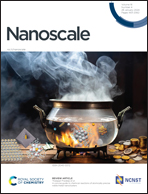Voltage-controlled magnetic anisotropy gradient-driven skyrmion-based half-adder and full-adder†
Abstract
Spintronic devices have revolutionized the way we process or store information compared to dissipative charge-based electronics. Among various spin-based technologies, skyrmions – topologically protected nano-size spin textures – have emerged as the most promising alternative for future data processing. Here, we have proposed binary adder circuits – central to most digital logic circuits – based on skyrmions. Using micromagnetic simulations, we have demonstrated half-adder and full-adder logic functionalities by precisely driving the skyrmions through voltage-controlled magnetic anisotropy gradient, besides taking advantage of the physical effects such as the skyrmion Hall effect, skyrmion–skyrmion topological repulsion and skyrmion-edge repulsions. The proposed voltage-control-based method of driving the skyrmions is energy efficient compared to the electrical current-driven approach, and it also overcomes the issue of Joule heating. A reliable operation in a wide range of Dzyaloshinskii–Moriya interaction strengths, magnetic anisotropy gradient, and dimensional parameters has been shown, which offers robustness to the device design. The results pave the way for the skyrmion-based computational architecture, which is significant for next-generation non-volatile data processing.



 Please wait while we load your content...
Please wait while we load your content...